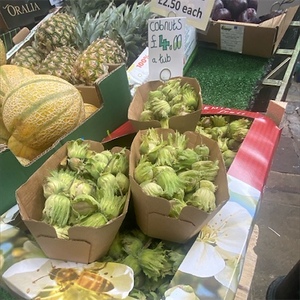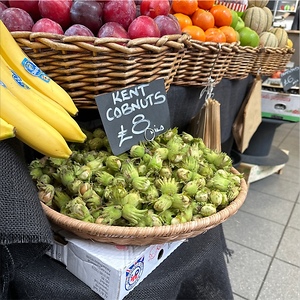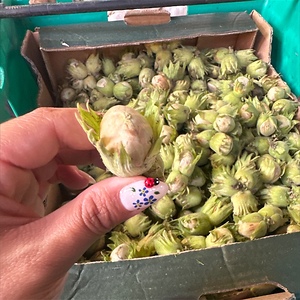


Cobnuts
Estimated Inventory, lb : 0
Description/Taste
Cobnuts are small to medium in size, averaging 1.5 to 2.5 centimeters in length and 1 to 1.5 centimeters in diameter, and are typically sold in soft, green, and frilled casings, also called husks or shucks. The young nuts are found in green shucks, and as they mature, the casings transform into a brown, papery, and dry consistency. The shucks are easy to remove, revealing nuts that range in shape from round, oval, to elongated. The nuts are enveloped in a hard brown shell that must be cracked open. The shell is easier to crack when young, but as it grows older, it becomes tough and hard to open. Once the shell is cracked, a thin layer of skin should be peeled and removed from the nut as it has a bitter taste and often adds an unpleasant flavor. Fresh Cobnuts are ivory to cream-colored when peeled and have a smooth, firm, and lightly striped or ridged exterior. The nuts are crunchy, creamy, and have a tender, chewy quality, and when young, they have a fresh, subtly earthy aroma reminiscent of raw coconut or freshly shelled peas. Cobnuts can be consumed raw and have a sweet, earthy, green, and nutty taste with nuances of citrus or coconut. Once roasted, the nuts become sweet and rich with malt and caramel undertones.
Seasons/Availability
Cobnuts are harvested in the late summer through fall, with a peak season in late August and September.
Current Facts
Cobnuts, botanically a part of the Coryllus genus, are cultivated versions of wild hazelnuts belonging to the Betulaceae family. The nuts appear in small clusters on deciduous trees and are distinct from wild hazelnuts as the cultivated versions are larger, more elongated, and sold fresh. There are two species that produce over sixty varieties of edible nuts under the Cobnut name: Coryllus avellana and Coryllus maxima. Coryllus avellana refers to Cobnuts that have a short outer husk, leading some of the nuts to be exposed during cultivation. Popular varieties within this species include Butler, Cosford, Nottingham Prolific, Red Majestic, Webbs Prize, and EMOA 1. Coryllus maxima is a species commonly known as Filberts, nuts that are entirely covered in a long shuck. In England, Filberts are interchangeably sold as Cobnuts, and typical varieties sold in markets are Ennis, Gunslebert, Kentish Cob or Lambert’s Filbert, Red Filbert, Purple Filbert, Merveille de Bollwiller or Hall’s Giant. Cobnuts are traditionally harvested when their shucks are still green, and the nuts are a seasonal delicacy in England, only available for around a month each year. It is important to note that Cobnut has become a catch-all term for any cultivated hazelnut, and the moniker is primarily used in the United Kingdom. Cobnuts can be consumed fresh or cooked and are favored for sweet and savory preparations.
Nutritional Value
Cobnuts are a source of fiber to regulate the digestive tract, vitamin E to protect the cells against the damage caused by free radicals, vitamin A to maintain healthy organs, and potassium to balance fluid levels within the body. The nuts also provide calcium to build strong bones and teeth, magnesium to control organ functioning, zinc to strengthen the immune system, phosphorus to repair tissues, and other nutrients, including B vitamins, manganese, folate, selenium, and oleic acid.
Applications
Cobnuts have a fresh, subtly nutty, sweet, and earthy taste suited for raw and cooked preparations. The nuts are traditionally consumed raw and out of hand and are often sprinkled with salt for added flavoring. During the Victorian Era, Cobnuts were a delicacy served fresh with port wine after dinner. Cobnuts can be eaten whole or chopped, and it is recommended to chop the nuts just before serving to prevent them from going stale. In addition to fresh preparations, Cobnuts are frequently roasted to develop a rich, nuttier taste. Roasted Cobnuts can be tossed into salads, used as a substitute for pine nuts in a pesto sauce, or crumbled and added to toppings over parfaits, streusel, and fruit cobblers. The nuts can also be cooked into soups, blended into sauces, or ground into biscuit batter. Cobnuts have a mild taste that complements various baked goods and desserts, and the nuts are added into cakes, baked into cookies, folded into bread and meringue, or used in place of almonds in macarons. They can also be used as a hazelnut substitute in any recipe. In Kent, England, Cobnuts are famously used in Kentish Cobnut cake. This customary dessert is comprised of a dense sponge cake sweetened with honey or sugar and flavored with ginger. Beyond sweet recipes, Cobnuts are also served with seafood and displayed on charcuterie boards. Cobnuts pair well with fruits such as pears, lemons, blackberries, and pomegranates, herbs including mint, basil, and parsley, cheeses such as parmesan, goat, and Wigmore, garlic, ginger, turmeric, and cinnamon. Fresh, husked, and peeled Cobnuts can be kept in the refrigerator’s crisper drawer for a few months or stored in honey for extended use. The nuts can also be dried and kept for several months.
Geography/History
Cobnuts are cultivated descendants of wild European hazelnuts, Coryllus avellana. Hazelnuts have been growing wild since ancient times, dating back to the Neolithic Period in 10,000 BCE, and were widely used as a food source throughout civilizations in Europe and Asia. It is said that the Romans were one of the first communities to begin cultivating hazelnuts. Later, during the Tudor Period in the 16th century, wild European hazelnuts were first commercially produced in England. The Victorians notably bred the nuts to become larger than their wild counterparts, and these newly developed varieties became known as Cobnuts. Throughout history, the county of Kent in southeast England was the primary region for Cobnut production, and at one point, over 7,000 acres were dedicated to nut cultivation. Cobnuts were traditionally grown on pieces of land called plats and were intermixed with cherry trees, apple trees, and hops. In 1830, Cobut production was centralized in West Kent, as the region had fertile soil suitable for Cobnut production. Cobnut cultivation was closely intertwined with hop production, as both ripened simultaneously. Hops pickers would harvest Cobnuts, and the fresh nuts were sold as a delicacy of the region. In the mid-20th century, hop production declined in Kent, and the agriculture industry shifted from hand-picking to mechanization. Cobnuts drastically declined in cultivation as the nuts could not be picked with machinery. Imported nuts from Turkey and California were introduced to British markets, leading Cobnuts to be grown on less than 250 acres in Kent. Despite almost disappearing, Cobnuts experienced a revival in the late 20th and 21st centuries as a locally sourced good in England. Today, around 400 acres are currently dedicated to Cobnut production in Kent, and production is focused around a “golden triangle” between Maidstone, Tonbridge, and Sevenoaks. When in season, Cobnuts are sold through farmer’s markets, directly from growers, online retailers, and select supermarkets in England. Cobnuts may also be found in other parts of Europe and under different names in Turkey, China, and the United States.










